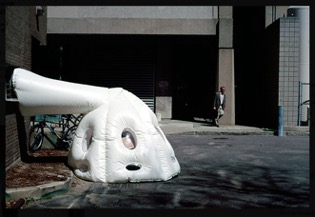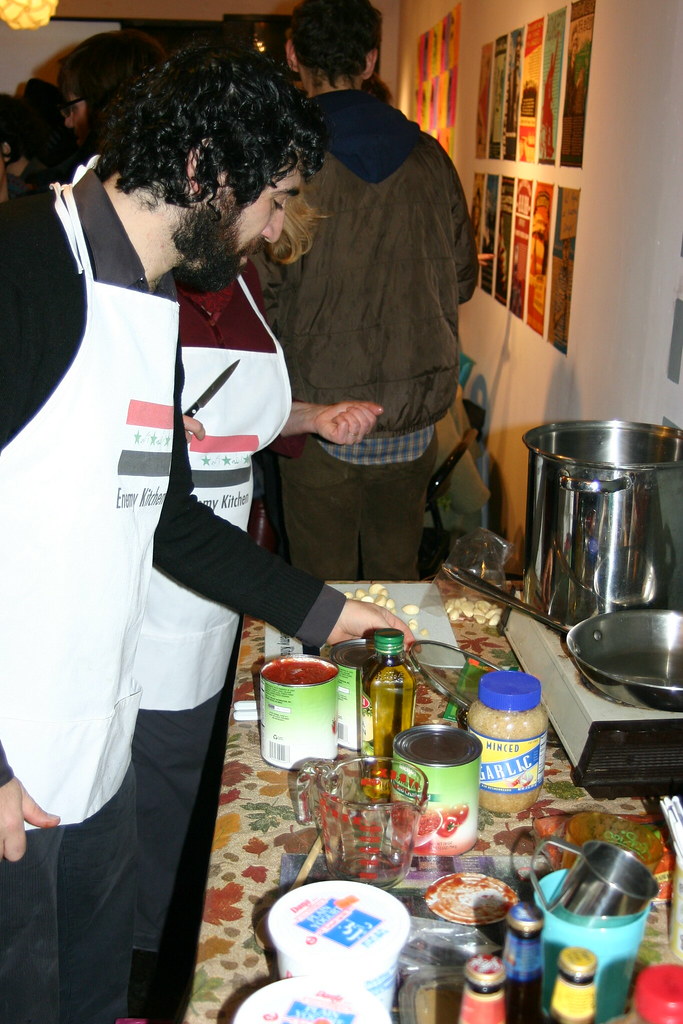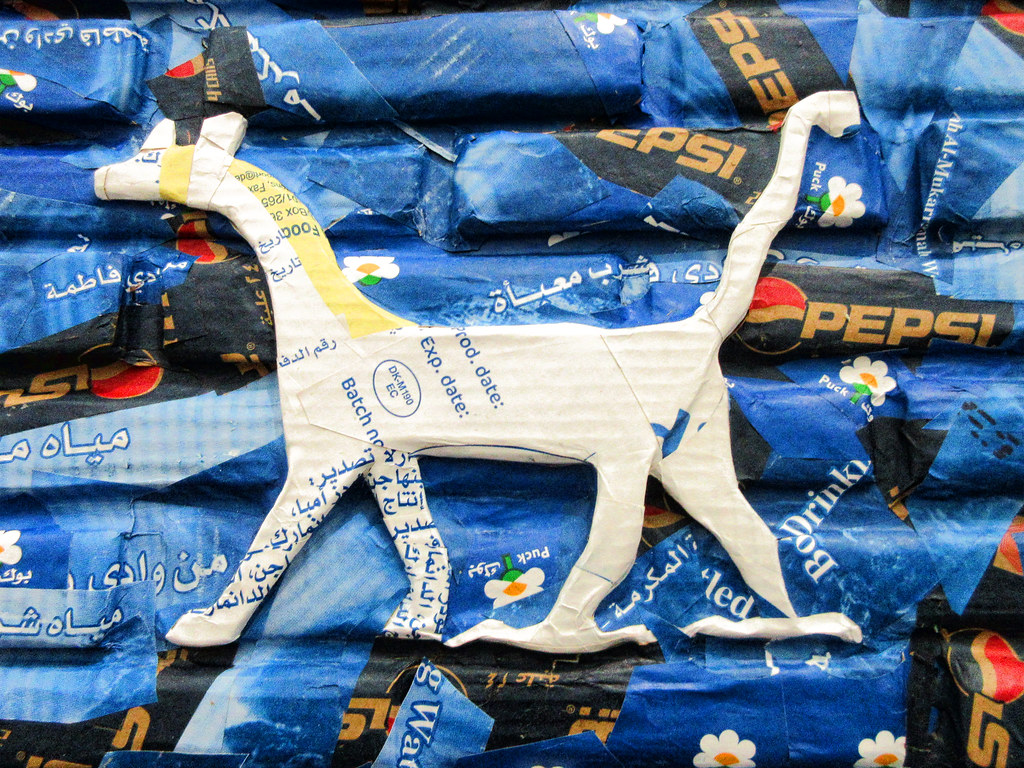By Annie Dell’Aria
Michael Rakowitz is the 2020 recipient of the Public Art Dialogue Award for achievement in the field of public art.
Rakowitz is an Iraqi-American artist who currently lives and works in Chicago. Rooted in socio-politically motivated conceptual art, social practice and relational aesthetics, his work is part of permanent collections in numerous institutions, and he has been exhibited worldwide, including at DOCUMENTA (13), MoMA PS1 , MassMOCA, the 16th Biennale of Sydney, and the 10th and 14th Istanbul Biennials, in addition to solo shows. In 1998, Rakowitz developed one of his most notable early works, paraSITE, for which he designed custom inflatable tents for the homeless that connected to existing outtake vents on the exteriors of buildings. Enemy Kitchen (2003-ongoing) is a project mounted in Chicago and elsewhere in which Baghdadi food, sometimes served by Iraq War veterans and cooked by Iraqi refugee chefs, serves as a conduit for conversations on conflict and culture. In 2018, Rakowitz was selected to create an installation in London’s Trafalgar Square for the Fourth Plinth project. The invisible enemy should not exist (2007-ongoing) is a full-scale recreation of a 700 BCE lamassu (stone statue/deity that guarded the gates of the ancient city of Nineveh) destroyed by Daesh terrorists in 2015. The sculpture, comprised of 10,000 empty Iraqi date syrup cans, is just one of the many works Rakowitz has developed as part of a larger project to re-create the approximately 7,000 objects looted from the Iraq Museum following the 2003 U.S. invasion of Iraq.
Rakowitz’s recent actions, aimed at a critique of cultural institutions and their philanthropic ties, have quickly gained international attention, including his request earlier this year that PS1 pause his video installation, RETURN (2004-ongoing), in protest of two MoMA board members’ investments in private prison and defense industries. The ongoing back and forth between Rakowitz and the museum, which ignored his request, has turned a spotlight on the accountability of the institution and its stakeholders.
Rakowitz has been honored with many awards, including (but not limited to) the 2020 Nasher Prize for Sculpture, a 2012 Tiffany Foundation Award, a 2008 Creative Capital Grant, and a 2006 New York Foundation for the Arts Fellowship Grant in Architecture and Environmental Structures.
Please join us in honoring Michael Rakowitz during the 108th CAA Annual Conference in Chicago at a ceremony and reception at the DePaul Museum of Art on Thursday, February 13 from 6:00-7:30 PM.*

Something I wanted to start with, to introduce people to your work and why PAD is honoring you, is to ask what drew you to working in the public realm and what connections you see between your work in galleries and museums and public art. There has been a lot of attention to your different actions in institutional critique with regard to museums like PS1 or the Whitney recently. I’m curious how you see that connecting to the public realm and what drew you to make work outside of an explicitly art context.
That’s a wonderful question. I had a moment in art school—I’d say it probably happened around my second year when I was in a welding class and one of the assignments was to make a wall relief. I was finding myself unenthusiastic about making a work that was its own form and was autonomous from the rest of the building. It seemed kind of like what everyone was doing, and I was interested in exploring that further. What would it mean if art really did kind of find a way into the everyday environment, through invading one’s routine as opposed to having people just be prepared for it, creating like a moment of rupture?
I remember with that assignment, I actually did a wall relief that made a kind of trompe l’oeil scenario. I made these caps for each of the cinder block bricks near the welding studio at SUNY Purchase, where I studied in a 10' x 10' area. It looked like the bricks were turning in front of you.
That really reminded some of my professors of the work of [artist and architect] James Wines and SITE, standing for Sculpture In The Environment. This led me to read some of the essays from that period of time in the 1970s and ‘80s about art in public space and the breakdown in communication that often existed when people entered into a museum, which was like a laboratory for ideas and for art. This was not necessarily a bad thing, but I wasn’t very excited about it.
I was interested in the radicality of being in a viewer’s space without them asking for it. And so that was something that led me to install small sculptures in match books. I’d bring the match books to smoke shops and leave them for people to find. I just kind of wanted to free the work that I was making from people’s preparedness to look for it, and that really made me very excited about public art as an opportunity to be truly untethered to institutions or to permissions.
That is the ethos that fueled work like paraSITE (1998-ongoing), which continues to this day. It is also apparent in some of the other works where I had support, like Return (2004-2006), commissioned by Creative Time. This work in particular really entered into the language of the quotidian import/export market, but it didn’t announce itself as an artwork.
Then, I started to develop other trajectories in my work. When I think about museums and museology, I also think about them as being a kind of public space because the issues do kind of relate to our experience of collective memory and issues around this myth of shared heritage. Not that human cultural heritage is not shared, but if you think about the encyclopedic museum, it is a Western construct. And if I think about the fate of the artifacts in those buildings, it can’t just be reduced to contemplation and appreciation. I think about them as a kind of hostage also. So when I work in the context of museums, I hope that I’m working in a way that is challenging the vitrine or even “breaking” it and looking for ways in which to recuperate those artifacts into a public imaginary as opposed to one that’s just relegated to the politeness of the museum.

That’s an excellent way to think about synthesizing these two spheres of your work. Since you brought up paraSITE, another question I had was with regard to objects and design. When we talk about dialogic aesthetics or social practice or conceptual art, often the objects themselves get overlooked, especially when we’re talking about moving into the public realm and breaking outside of the vitrine. Yet, with paraSITE and a lot of your earlier work I see a very sincere interest in design and intersections with design. So I’m curious how you approach the objects that you engage in your more public work—whether they be found objects, objects you’ve made, or objects that are eaten—in terms of their formal or material considerations. How do you see the role of the physical objects that you activate in your work in relationship to the kind of dialogues that you’re prompting?
Well [this relates to] one of the things that I learned when I was studying with people like [artist] Krzysztof Wodiczko at M.I.T. It was the first time that I had ever read [psychoanalyst D.W.] Winnicott and the conversation around the transitional object. That made a lot of sense to me because a transitional object is something that is experienced in childhood, but I think we continue to experience it in the way that objects themselves can become vessels for things like grief, for instance.
I think about things like the votive statues from the Iraq Museum. In antiquity, they were supposed to be surrogates for the worshippers. The idea was that you could go to the shrine and leave them behind, and they would continue to pray for you. But then, in the midst of the Iraq War [2003-present], I found myself vacillating between outrage and sincere interest in why people were mourning the loss of the artifact. I was always waiting for the outrage around lost objects to transition to outrage around lost lives, but I realized that people were projecting their grief onto these surrogates. The projections may be something like a psychological defense mechanism, in a way, and that got me to think about the object again.
When I thought about the object while making tarps [for paraSITE], I’d always realize that in order to really talk about dispossession and homelessness in a way that could somehow shake up the way that it’s usually discussed would be to give it a new skin and a new appearance. I love sculpting, and I genuinely love drawing. The engagement with each of the people that I’ve worked with has always involved drawing, because we design it together. It becomes a device of language. When those shelters were constructed, it was a residue of the social experience.

It’s a little bit like why cooking is important to me [in a work like Enemy Kitchen]: because I know from my experience growing up with Iraqi food that a dolma, a stuffed grape leaf, or a kubbeh, which is a dumpling, is the result of a group of hands of people that were making this food and were also having conversations while it was being made. The head and the hand were doing two different things at that moment. Oftentimes, when you are working with your hands, it frees up other things to happen in your brain. I’m very interested in that. So, these objects themselves tell a story, but the story is–I hope–told through the aggregation of material. The sheer scale of it lets you know that there were other things happening while they were being made.
I also think that there’s something really wonderful when we talk about cooking. It’s taught me a lot about sculpture and helped me once again appreciate sculpture. When I think about the way that enzymes can change proteins when you’re cooking, I also consider the way that artwork can in fact be that enzyme that will shift things. A protein is not stagnant–it moves on and evolves from the form that it’s in when it’s affected. I think for me the object can do that as well. It can hold a space and materialize something that otherwise might be so ephemeral that it can only ever be recalled through the anecdote, and I’m not always there to do that.
In the past you suggested that you want “fearless listening to enable fearless speaking” in your work. Could you comment on the importance of listening in your practice and perhaps also in the art world, the public realm or in general? What is the significance of listening and producing art? How do you understand listening as perhaps a transformative practice?
Another beautiful question. I think that the things that I learned from Krzysztof and [artist] Joan Jonas was to slow down and take stock of what a project is. For instance, one of the things I didn’t comprehend ahead of paraSITE was just how much the project was also about [my having been] the child of two post-Holocaust Jews . One side of [my] family were actually refugees from Iraq. Joan Jonas, who listened to me talk about the shelter, shared with me that it was so much more than just the shelter—it’s the story, and it's the “Wandering Jew,” and that I should feel permission to story-tell.

But the stories I was telling were stories that the [homeless] participants told me, because I don’t have experience living on the streets. I really tried to listen to those experiences when coming up with the design, as opposed to saying, “Oh, this is what you need.” They were telling me what their problems were, and in this way, it was like the problem-solving. It was also a way of troublemaking because I exposed each individual story to the city; I didn’t just make something designed for the average or the mean, the statistic—but that [result] doesn’t come without listening.
It’s something that I always liked doing when I was a kid–listening to [conversations between] people who visited with my family and people who were older than me and had more experience. I also think there was a certain kind of slowness to these conversations, and I grew up around that slowness. We weren’t told to hurry up [with our conversation], and there was something about sitting and giving somebody space to talk that was important. I felt like, as I started doing these projects, I didn’t to do what designers oftentimes do–they will come up with a solution, but they haven’t engaged the people who have the problem. And I’m not necessarily making solutions, but I’m making work about things that interest me and also trouble me. Things that draw my attention because of what I’m interested in.
In doing a project that would meaningfully incorporate the stories of voices from Iraq and distill them through the voice of a former Iraqi broadcaster who himself becomes a refugee in the U.S., I really needed a lot of time to work with the [Iraqi diaspora] community in Philadelphia. I’m specifically speaking about the project Radio Silence (2018). [I needed time to] allow for there to be a foregrounding of their experiences, but in order to get there, you also have to introduce yourself, tell somebody why you’re interested in them, and then develop a relationship.
So, these projects that I do are all very nice, fun projects, but none of them are done quickly. I think it’s important that you listen; listening is also an aggregation of experiences happening to people that are not just the material of my work—they are people—and I try my best to make that clear, because when things happened to those people, I want to be able to have that register in the work.
The “fearless listening to enable fearless speaking” is a phrase that comes from Foucault and from a certain kind of experience with psychoanalysis, I believe. An analyst is patient. I’m not saying that I’m being an analyst in this situation, but I’m struck by the kind of hospitality that can come in the gesture of giving people space to react, and to let them guide my work and affect my intention.
You asked the question about the relationship of institutions to working in the public realm. I do think that we’re living in the age of reaction. Everything happens so quickly, and I think about my experience with MoMA PS1 [this year], for instance. It’s shocking that I’m being met with silence by the museum. It’s not characteristic of how I understood that institution when I worked there two decades ago. For institutions to be unwilling to listen and slow things down in order to allow for the people that they’re working with and the audiences that they’re affecting to somehow come in and be a part of the way that we move forward is alarming.
I think we’re living in a very different time now. I actually do think we’re living in a time when there is an erosion of creative freedom. But I do think that it’s all a part of what it means to expand to the point where MoMA has expanded. It’s expanded to the point where it’s running itself like a billion-dollar corporation, so it can’t deal with dissent because it’s about keeping certain stakeholders happy. I think that that’s part of speeding up. That is the way that we’re living in whatever form of capitalism we want to call this now. For me, that’s part of fearlessly listening and fearlessly slowing down a little bit.
*This interview has been lightly edited throughout.



